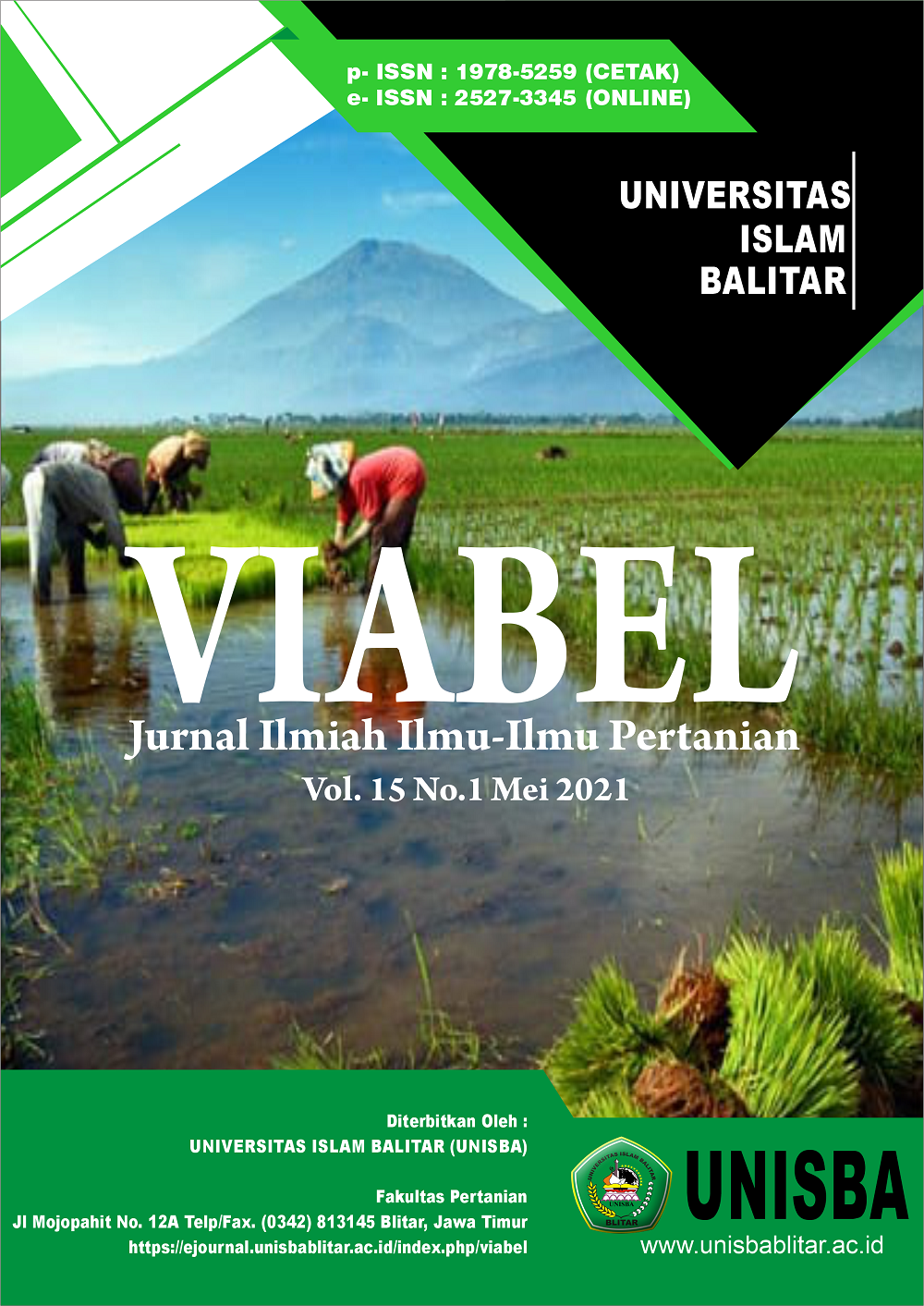The IN VIVO UTILIZATION OF ANTAGONISTIC INTERACTION ABILITIES OF BIOLOGICAL AGENTS AGAINST PATHOGENIC FUNGUS OF Fusarium spp. FOR CONTROL OF STEM ROT DISEASE IN THE FIG CUTTINGS (Ficus carica L) AND ITS EFFECT ON PLANT GROWTH
Tin, Trichoderma
DOI:
https://doi.org/10.35457/viabel.v15i1.1391Keywords:
Keywords: fig, Fusarium spp., biological agent, Trichoderma, MancozebAbstract
ABSTRACT
This study aims to determine the effectiveness of the inoculation of antagonistic biological agents in controlling stem rot disease caused by the pathogenic fungus Fusarium spp., and to increase the growth of fig stem cuttings (Ficus carica L.). This research was conducted at the Greenhouse of the Faculty of Agriculture, Islamic University of Batik Surakarta (UIBS), from September 2020 to December 2020. This study used a completely randomized design (CRD)., with 6 types of treatment, consisting of control, Trichoderma, Gliocladium, Corynebacterium, PGPR, and synthetic fungicide Mancozeb as a comparison, with 3 repetitions and 3 sub-repetitions. Observations consisted of several parameters, namely: disease incubation period, disease incidence, disease severity, shoot growth period, shoot height, leaf number, leaf area, root length, and number of roots. The results showed that Trichoderma treatment gave the best results for all observed parameters, even better than Mancozeb which is usually used by farmers. This is because Trichoderma has the ability of antagonistic in the form of very aggressive competition, producing antibiotic, and mycoparasitic mechanism against the pathogenic fungus Fusarium spp., so its utilization can be applied in organic farming to control stem rot disease which is more environmentally friendly. Trichoderma can also be used as biofertilizer because it has the ability as a good biodecomposer, its can breakdown nitrogen nutrients, dissolve phosphate, and provide micro nutrients, and even release the hormones auxin, cytokinins and ethylene, so that its effectiveness can stimulate and increase vegetative growth of fig plants in the form of shoots, leaves and roots.
Keywords: fig, Fusarium spp., biological agent, Trichoderma, Mancozeb
Downloads
References
Baker, K. F., dan Cook, R. J. 1982. Biological Control of Plant Pathogens. American Phytopathology Society Press and Publishing. Minnessota. USA.
Chamzurni, T., Sriwati, R., dan Selian, R.D 2011. Efektivitas Dosis dan Waktu Aplikasi Trichoderma virens terhadap Serangan Sclerotium rolfsii pada Kedelai. Jurnal Floratek. 6(1): 62-73.
Duaja, M. D., Kartika, E., dan Gusniwati. 2020. Pembiakan Tanaman Secara Vegetatif. Penerbit Fakultas Ekonomi dan Bisnis Universitas Jambi, Jambi.
Herlina, L., dan P. Dewi. 2010. Penggunaan Kompos Bahan Aktif Trichoderma harzanium dalam Meningkatkan Pertumbuhan Tanaman Cabai. Jurnal Sains dan Teknologi. 8(2): 11-25.
Jahén-Rivera, S. N., Gómez-Rodríguez, O., dan Espinosa-Victoria, D. 2020. Isolation and Identification of Pathogens Causing Stem Rot of the Fig Tree (Ficus carica). Mexican Journal of Phytopathology. 38(2): 1–11
Joga, N. 2017. Mewariskan Kota Layak Huni. Penerbit Gramedia. Jakarta.
Juariyah, S., Tondok, E. T. dan Sinaga, M. S. 2018. Trichoderma dan Gliocladium untuk Mengendalikan Penyakit Busuk Akar Fusarium pada Bibit Kelapa Sawit (Elaeis guineensis Jacq). Jurnal Fitopatologi Indonesia. 14(6): 196–204.
Kardinan, A. 2016. Sistem Pertanian Organik: Falsafah, Prinsip, Inspeksi. Penerbit Intimedia. Malang.
Katriani, M. 2013. Analisis Morfofisiologi dan Hasil Jagung yang Diaplikasikan Trichoderma spp dan NPK pada Lahan Kering. Disertasi. Program Pascasarjana Universitas Hasanuddin, Makassar.
Khariruddin. 2015. Morfologi dan Anatomi Buah dalam Al-Qur’an. Skripsi. Fakultas Ushuluddin dan Humanoria Universitas Islam Negeri Walisongo, Semarang.
Kusnadi, Hamdiyati, Y., dan Fitriani, A. 2003. Mikrobiologi. Penerbit FMIPA Universitas Pendidikan Indonesia, Bandung.
Maulida, N. K. 2020. Uji Keefektifan Tiga Isolat Trichoderma harzianum terhadap Penyakit Moler Bawang Merah In Planta. Skripsi. Fakultas Pertanian Universitas Jenderal Soedirman, Purwokerto.
Nuraufan, F. R. 2021. Pertumbuhan Stek Tanaman Kelor (Moringa oleifera Lam.) terhadap Waktu Inokulasi Trichoderma dan Berbagai Level Pupuk Limbah Baglog. Skripsi. Fakultas Pertanian UPNV Yogyakarta, Yogyakarta.
Nuryani, W., Silvia, E., Hanudin, dan Budiarto, K. 2018. Aplikasi Biofungisida Berbahan Aktif Corynebacterium sp. Ramah Lingkungan dalam Pengendalian Penyakit Karat Putih pada Krisan. Jurnal Teknologi Lingkungan. 19(1): 23–32.
Rahmah, D. S., dan Pujiastuti, E. 2016. Prospek Bisnis Buah Tin. Penerbit Trubus Swadaya, Jakarta.
Rifai, M. R., Widowati, H., dan Sutanto, A. 2020. Sinergisme dan Antagonisme Beberapa Jenis Isolat Bakteri yang Dikonsursiumkan. Jurnal BIOLOVA. 1(1): 21–26.
Rosanti, D. 2013. Morfologi Tumbuhan. Penerbit Erlangga, Jakarta.
Downloads
Published
Issue
Section
License
Copyright (c) 2021 VIABEL: Jurnal Ilmiah Ilmu-Ilmu Pertanian

This work is licensed under a Creative Commons Attribution-ShareAlike 4.0 International License.
Authors who publish with this journal agree to the following terms:
- Copyright on any article is retained by the author(s).
- The author grants the journal, right of first publication with the work simultaneously licensed under a Creative Commons Attribution License that allows others to share the work with an acknowledgment of the work’s authorship and initial publication in this journal.
- Authors are able to enter into separate, additional contractual arrangements for the non-exclusive distribution of the journal’s published version of the work (e.g., post it to an institutional repository or publish it in a book), with an acknowledgment of its initial publication in this journal.
- Authors are permitted and encouraged to post their work online (e.g., in institutional repositories or on their website) prior to and during the submission process, as it can lead to productive exchanges, as well as earlier and greater citation of published work.
- The article and any associated published material is distributed under the Creative Commons Attribution-ShareAlike 4.0 International License










.png)




